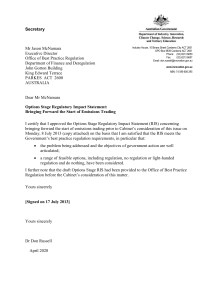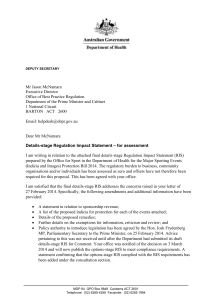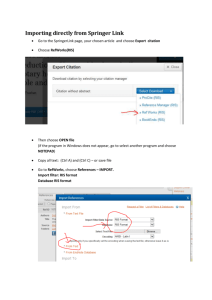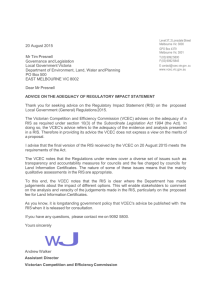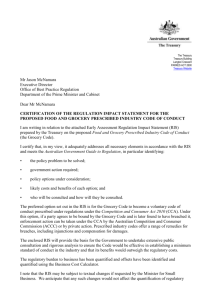Document 13308289
advertisement
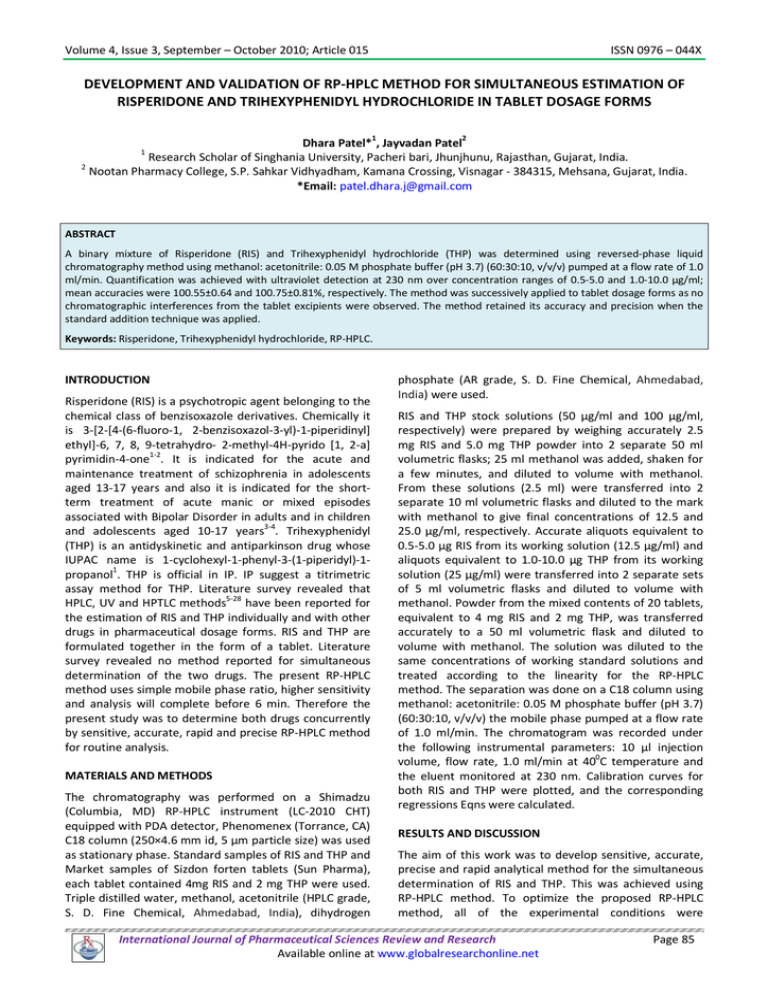
Volume 4, Issue 3, September – October 2010; Article 015 ISSN 0976 – 044X DEVELOPMENT AND VALIDATION OF RP-HPLC METHOD FOR SIMULTANEOUS ESTIMATION OF RISPERIDONE AND TRIHEXYPHENIDYL HYDROCHLORIDE IN TABLET DOSAGE FORMS Dhara Patel*1, Jayvadan Patel2 Research Scholar of Singhania University, Pacheri bari, Jhunjhunu, Rajasthan, Gujarat, India. 2 Nootan Pharmacy College, S.P. Sahkar Vidhyadham, Kamana Crossing, Visnagar - 384315, Mehsana, Gujarat, India. *Email: patel.dhara.j@gmail.com 1 ABSTRACT A binary mixture of Risperidone (RIS) and Trihexyphenidyl hydrochloride (THP) was determined using reversed-phase liquid chromatography method using methanol: acetonitrile: 0.05 M phosphate buffer (pH 3.7) (60:30:10, v/v/v) pumped at a flow rate of 1.0 ml/min. Quantification was achieved with ultraviolet detection at 230 nm over concentration ranges of 0.5-5.0 and 1.0-10.0 µg/ml; mean accuracies were 100.55±0.64 and 100.75±0.81%, respectively. The method was successively applied to tablet dosage forms as no chromatographic interferences from the tablet excipients were observed. The method retained its accuracy and precision when the standard addition technique was applied. Keywords: Risperidone, Trihexyphenidyl hydrochloride, RP-HPLC. INTRODUCTION Risperidone (RIS) is a psychotropic agent belonging to the chemical class of benzisoxazole derivatives. Chemically it is 3-[2-[4-(6-fluoro-1, 2-benzisoxazol-3-yl)-1-piperidinyl] ethyl]-6, 7, 8, 9-tetrahydro- 2-methyl-4H-pyrido [1, 2-a] pyrimidin-4-one1-2. It is indicated for the acute and maintenance treatment of schizophrenia in adolescents aged 13-17 years and also it is indicated for the shortterm treatment of acute manic or mixed episodes associated with Bipolar Disorder in adults and in children and adolescents aged 10-17 years3-4. Trihexyphenidyl (THP) is an antidyskinetic and antiparkinson drug whose IUPAC name is 1-cyclohexyl-1-phenyl-3-(1-piperidyl)-1propanol1. THP is official in IP. IP suggest a titrimetric assay method for THP. Literature survey revealed that HPLC, UV and HPTLC methods5-28 have been reported for the estimation of RIS and THP individually and with other drugs in pharmaceutical dosage forms. RIS and THP are formulated together in the form of a tablet. Literature survey revealed no method reported for simultaneous determination of the two drugs. The present RP-HPLC method uses simple mobile phase ratio, higher sensitivity and analysis will complete before 6 min. Therefore the present study was to determine both drugs concurrently by sensitive, accurate, rapid and precise RP-HPLC method for routine analysis. MATERIALS AND METHODS The chromatography was performed on a Shimadzu (Columbia, MD) RP-HPLC instrument (LC-2010 CHT) equipped with PDA detector, Phenomenex (Torrance, CA) C18 column (250×4.6 mm id, 5 µm particle size) was used as stationary phase. Standard samples of RIS and THP and Market samples of Sizdon forten tablets (Sun Pharma), each tablet contained 4mg RIS and 2 mg THP were used. Triple distilled water, methanol, acetonitrile (HPLC grade, S. D. Fine Chemical, Ahmedabad, India), dihydrogen phosphate (AR grade, S. D. Fine Chemical, Ahmedabad, India) were used. RIS and THP stock solutions (50 µg/ml and 100 µg/ml, respectively) were prepared by weighing accurately 2.5 mg RIS and 5.0 mg THP powder into 2 separate 50 ml volumetric flasks; 25 ml methanol was added, shaken for a few minutes, and diluted to volume with methanol. From these solutions (2.5 ml) were transferred into 2 separate 10 ml volumetric flasks and diluted to the mark with methanol to give final concentrations of 12.5 and 25.0 µg/ml, respectively. Accurate aliquots equivalent to 0.5-5.0 µg RIS from its working solution (12.5 µg/ml) and aliquots equivalent to 1.0-10.0 µg THP from its working solution (25 µg/ml) were transferred into 2 separate sets of 5 ml volumetric flasks and diluted to volume with methanol. Powder from the mixed contents of 20 tablets, equivalent to 4 mg RIS and 2 mg THP, was transferred accurately to a 50 ml volumetric flask and diluted to volume with methanol. The solution was diluted to the same concentrations of working standard solutions and treated according to the linearity for the RP-HPLC method. The separation was done on a C18 column using methanol: acetonitrile: 0.05 M phosphate buffer (pH 3.7) (60:30:10, v/v/v) the mobile phase pumped at a flow rate of 1.0 ml/min. The chromatogram was recorded under the following instrumental parameters: 10 µl injection volume, flow rate, 1.0 ml/min at 400C temperature and the eluent monitored at 230 nm. Calibration curves for both RIS and THP were plotted, and the corresponding regressions Eqns were calculated. RESULTS AND DISCUSSION The aim of this work was to develop sensitive, accurate, precise and rapid analytical method for the simultaneous determination of RIS and THP. This was achieved using RP-HPLC method. To optimize the proposed RP-HPLC method, all of the experimental conditions were International Journal of Pharmaceutical Sciences Review and Research Available online at www.globalresearchonline.net Page 85 Volume 4, Issue 3, September – October 2010; Article 015 ISSN 0976 – 044X investigated. For the choice of the stationary phase, reversed-phase separation was preferred due to the drawbacks of the normal phase, e.g., hydration of silica with water that can cause peak tailing. To optimize the mobile phase, different systems were tried for chromatographic separation of the two components by combining homogenous design and solvent polarity optimization. The best resolution was achieved using a mobile phase consisting of methanol: acetonitrile: 0.05 M phosphate buffer (pH 3.7) (60:30:10, v/v/v), which gave good resolution and sensitivity of both drugs (fig. 1). Table 1: System suitability test parameters for RIS & THP for proposed RP-HPLC method Proposed methods RP-HPLC a a RIS± % RSD THP± % RSD 3.797±0.11 5.389± 0.18 Parameters Retention time, min Tailing factor Asymmetry factor Theoretical plates Repeatability of b measurement (n = 6) 1.15±0.16 1.09±0.51 4253.8±0.64 1.31±0.52 1.20±0.18 6293.98±1.34 1.82 1.49 a RSD is a Relative standard deviation, determinations Figure 1: RP-HPLC chromatogram of RIS and THP at 230 nm System suitability testing of the RP-HPLC method gave good relative retention time = 1.592; theoretical plates = 4253.8 and 6293.98; asymmetry factor (A) = 1.09 and 1.20; and tailing factor (T) = 1.15 and 1.31 for RIS and THP, respectively (Table 1). b n is number of A linear relation was obtained between peak area and the concentration of the two drugs in the range of 0.5-5.0 and 1.0-10.0 µg/ml for RIS and THP, respectively. The linear regressions Eqns were computed as: Y=154926 X + 11501, r= 0.9995 and Y=126789 X+ 45913, r= 0.9979, where Y is the area under the peak, X is the concentration in µg/ml, and r is the correlation coefficient. Results obtained by applying the RP-HPLC procedure showed that RIS and THP can be simultaneously analyzed in the prepared mixtures with mean recoveries of 100.55±0.64 and 100.75±0.81 %, respectively. The proposed method has been applied to assay RIS and THP in tablets without any interference from the additives (Table 2). The limit of detection for RIS and THP were found to be 0.05µg/ml and 0.5µg/ml, respectively; the limit of quantification for RIS and THP were found to be 0.5µg/ml and 1.0 µg/ml, respectively by visual method. The low % CV values of intra-day (0.151.41 for RIS and 0.46-1.38 for THP) and inter-day (0.191.67 for RIS and 0.37-1.62 for THP) precision reveal that the proposed method is precise. Thus, the proposed procedure can be used in routine analysis. Table 2: Assay results for tablets using the proposed methods (RP-HPLC) Mix. a Amount of drug added (mg) Amount of drug found (mg) % Amount found (na=3) ± SDb RIS THP RIS THP RIS THP 1 4 2 4.02 1.99 100.50.19 99.50.16 2 4 2 3.97 2.01 99.250.44 100.50.21 n is number of determinations, SD is a Standard deviation, RIS is Risperidone, THP is Trihexyphenidyl HCl b Table 3: Application of the standard addition technique to the analysis of RIS and THP in tablets by the proposed methods Proposed methods RP-HPLC Amount of drug taken (µg/ml or ng/spot) Amount of drug added (µg/ml or ng/spot) Amount of drug found (µg/ml or ng/spot) a b % Recovery (n =3) ± SD RIS THP RIS THP RIS THP RIS THP 1 2 0.5 2 1.504 4.04 100.31±0.50 100.72±0.79 1 2 1 4 2.014 6.01 100.7±1.16 100.79±0.58 2 1.5 6 2.516 8.51 100.66±0.22 b n is number of determinations, SD is a Standard deviation 100.63±1.07 1 a International Journal of Pharmaceutical Sciences Review and Research Available online at www.globalresearchonline.net Page 86 Volume 4, Issue 3, September – October 2010; Article 015 CONCLUSION We have successfully developed a new simple RP-HPLC method for the simultaneous estimation of Risperidone and Trihexyphenidyl HCl combination in mixture using simple mobile phase buffer, methanol and acetonitrile. Rapidity and capability of qualifying very low concentration of respective drugs, made them useful for variety of analyses, including pure drug analysis, assay of formulations and stability studies analysis. The purposed method did not utilize any extraction step for recovering the drug from the formulation excipient matrixes and their by decreased the degree of error, time in estimation of the drugs and the overall cost of the analysis. The method was validated and found to be simple, sensitive, accurate, precise and economical. The proposed method could be applied for routine analysis in quality control laboratories. Acknowledgement: The authors are grateful to Sun Pharmaceuticals Ltd (Vadoadara, Gujarat, India) for the gift samples of pure RIS and THP, respectively. The authors would also like to thank anonymous reviewers for their helpful comments. Of course, all remaining errors are mine. REFERENCES 1. The Merck Index,13th ed, Merck Research Laboratories division of Merck and company, NJ, USA, 2001, 1627,1651. 2. British Pharmacopoeia, Vol.I, 4th Edn., 2002, 1,1500. 3. Hardman, G., Limbid, L.E. and Gilman, A.G. The Pharmacological Basis of Therapeutics. Edn 10, McGraw Hill, 2001, 279. 4. Tripathi K.D. Essentials of Medical Pharmacology. Edn 5, Jaypee Brothers Medical publishers, New Delhi,747,150,388, 391,394,396,397. 5. Baldaniya SL, Bhatt KK, Mehta RS, Shah DA. RP-HPLC estimation of Risperidone in tablet dosage form. Indian J. of Pharm. Sci 2008;70 (4): 494- 497. 6. Singhvi I, Goyal A. Visible spectrophotometric determination of Risperidone in tablet formulations accessed on www.pharmainfo.net on 25/04/08 7. Huang MZ, Shentu J Z, Chen J C, Liu J, Zhou H. Determination of Risperidone in human plasma by HPLC-MS and its application to a pharmacokinetic study in Chinese volunteer. J Zhejiang Univ Sci B 2008; 9(2):114-120. 8. Zhou Z, L xin, Kunyan L, Zhihong X, Zeneng C, Wenxin P, Wang F, Zhu R, Huande L. Simultaneous determination of clozapine, olanzapine, risperidone and quetiapine in plasma by high-performance liquid chromatography- electrospray ionization mass spectrometry. J. Chromatogr B 2004; 802 (2): 257262. ISSN 0976 – 044X 9. Bartlett MG, Zhang G, Terry Jr.A V. Simultaneous determination of five antipsychotic drugs in rat plasma by high performance liquid chromatography. J. Chromatogr B 2007; 856(1-2): 20-28. 10. Subbaiah G, Singh S, Bhatt J. Liquid chromatography/tandem mass spectrometry method for simultaneous determination of risperidone and its active metabolite 9hydroxyrisperidone in human plasma. Rapid Communications in Mass Spectrometry 2006; 20(14): 2109-2114. 11. Danel C, Barthelemy C, Azarzar D, Robert H, Bonte J P, Odou P, Vaccher C. Analytical and semipreparative enantioseperation of 9- hydroxyl risperidone, the main metabolite of RIS, using highperformance liquid chromatography and capillary electrophoresis. Validation and determination of enatiomeric purity. J. Chromatogr A 2007; 1163(12): 228-36. 12. Joshi A, Jeyaseelan C, Jugade R. Differential pulse polarographic studies of risperidone in pharmaceutical formulations. Croat. Chem. Acta 2006;79(4): 541-544. 13. Song Z, Wang C. Sensitive chemiluminescence assay for Risperidone in pharmaceutical preparations. J. Pharm.Biomed. Anal., 2004; 36(3): 491-494. 14. Schatz DS, Saria A. Simultaneous Determination of Paroxetine, Risperidone and 9-Hydroxyrisperidone in Human Plasma by High-Performance Liquid Chromatography with Coulometric Detection. Pharmacology 2000; 60:51-56. 15. Handan HE, Gordon M, Bill W, Kamal K. Development and application of a specific and sensitive radioimmunoassay for trihexyphenidyl to a pharmacokinetic study in humans. Journal of Pharmaceutical Sciences 2006; 84(5): 561 – 567. 16. Mahadik KR, Aggarwal H and Kaul N. Simultaneous HPTLC estimation of trifluoperazine HCL, trihexyphenidyl HCL and chlorpromazine HCL in tablet dosage form. J. Indian Drugs 2003; 40(6): 340341. 17. Mahadik KR, Aggarwal H and Kaul N. HPLC method for simultaneous estimation of Trihexyphenidyl hydrochloride and chlorpromazine hydrochloride from tablet dosage form. J. Indian Drugs 2002; 39(8): 441-445. 18. Pradas TN, Sivakumar M.HPLC quantification of a tricomponent psychiatric formulation containing chlorpromazine, trifluoperazine and trihexyphenidyl. J. Pharmazie 1992; 47(3): 231. 19. Capka V, Xu Y and Chen YH. Stereoselective determination of trihexyphenidyl in human serum by LCESI-MS. J. Pharm Biomed Anal.1999; 21(3): 507-17. International Journal of Pharmaceutical Sciences Review and Research Available online at www.globalresearchonline.net Page 87 Volume 4, Issue 3, September – October 2010; Article 015 ISSN 0976 – 044X 20. Vargas G, Havel J, Babackova L and Patocka J. Determination of drugs used as anti-Parkinson's disease drugs in urine and serum by capillary electrophoresis. J. Capillary Electrophor 1998; 5(34): 153-158. 24. Lugnier A, Kintz P, Tracqui A, Ludes B, Mangin P, and Chaumont AJ. The determination of trihexyphenidyl and its hydroxyl metabolite by gas chromatography. Acta Med Leg Soc.1989; 39(1): 389-391. 21. Desage M, Rousseau-Tsangaris M, Lecompte D and Brazier JL, Quantitation of trihexyphenidyl from plasma using a mass-selective detector and electron impact ionization. J. Chromatogr 1991; 571(1-2): 250-256. 22. Owen JA, Sribney M, Lawson JS, Delva N and Letemendia F. Capillary gas chromatography of trihexyphenidyl, procyclidine and cycrimine in biological fluids. J. Chromatogr 1989; 494: 135-142. 23. Kintz P, Godelar B, Mangin P, Chaumont AJ and Lugnier AA. Identification and quantification of trihexyphenidyl and its hydroxylated metabolite by gas chromatography with nitrogen phosphorus detection. J. Anal Toxicol. 1989; 13(1): 47-49. 25. Bargo E. GLC determination of trihexyphenidyl hydrochloride dosage forms. J. Pharm Sci. 1979; 68(4): 503-505. 26. Lovejoy DJ. A rapid gas chromatographic method for the determination of benzhexol hydrochloride. J Chromatogr.1971; 57(1): 137-138. 27. Papke E. Gravimetric methods for determination of Parkopan, Spasman and Dispasmol. On the analysis of some spasmolytic. Pharmazie 1968; 23(3): 148150. 28. Bozsai G and Vastagh G. The polarographic determination of primidone and trihexyphenidyl (Benzhexol). J. Pharm Zentralhalle Dtschl. 1964; 103: 403-408. *********** International Journal of Pharmaceutical Sciences Review and Research Available online at www.globalresearchonline.net Page 88
